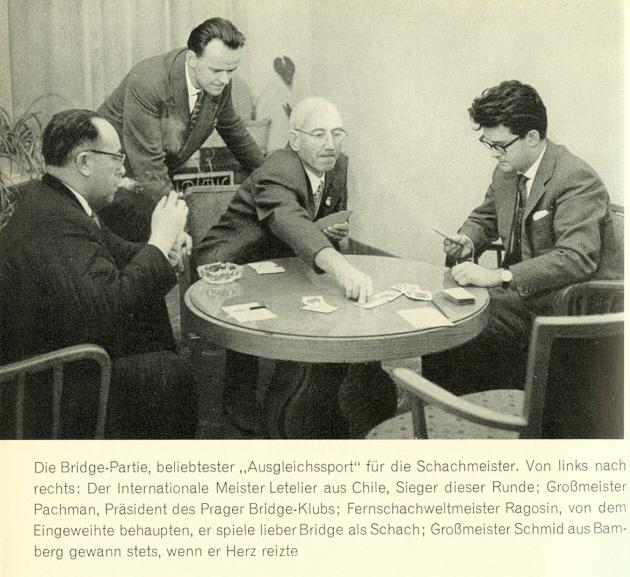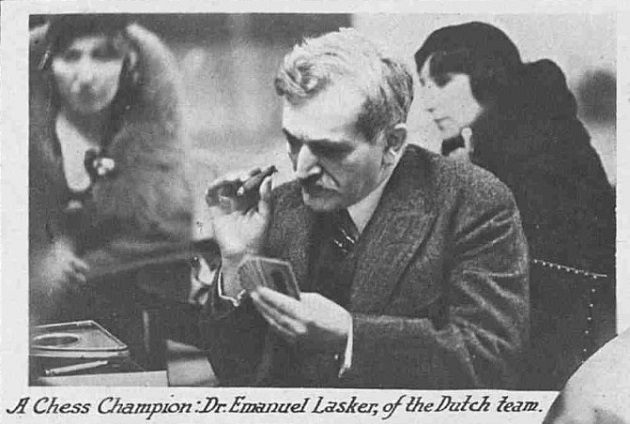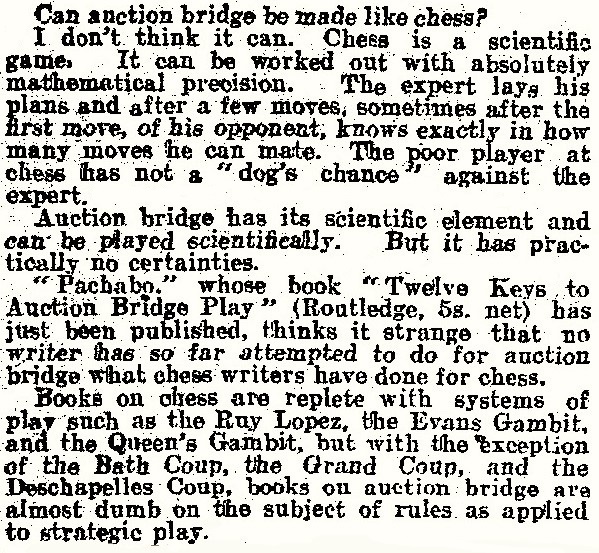
Edward Winter

‘... Emanuel Lasker, whose brain was second to none, mastered every move of bridge without being a successful performer. I never saw him play bridge, but hearsay tells of his rigidity. I saw Capablanca play bridge. He played very well indeed, but woodenly. He whose chess was so fluid. These two great chessplayers failed to develop a “flair” for cards.’
This is the late Gerald Abrahams in his essay Mental Processes in Chess and Bridge on pages 120-132 of Not Only Chess (London, 1974). The account contradicts several other recorded views of Lasker and Capablanca’s card skills, but Abrahams was an author (and an authority) on both chess and bridge.
(38)
From George Stern (Woden, Australia):
‘C.N. 38 refers to the late Gerald Abrahams as “an authority on both chess and bridge”. I cannot judge the quality of his expertise in bridge, but I am less than an ardent admirer of his in the field of chess. I have before me the 1975-6 Year Book of the Encyclopaedia Judaica (Keter Publishing House Jerusalem Ltd.) On page 253, under the heading of “Chess” , Gerald Abrahams writes:
“Bobby Fischer lost the World Championship in 1975 when he refused to play the challenger Vassily Karpov. ... The British chess championship held in August 1974 ended in a tie between seven players, of whom three, William Hartstone, ... Jonathan Mestel, ... and Michael Stean, are Jewish. ... The play-off was won by Botterell.
... Israel chess has been further strengthened by the arrival from USSR of Grand Master Leonid Shumkovitch ...”
The entry ends with a blurb for his book, Not Only Chess. In the Decennial Book 1973-82 of the same work (issued by the same publisher), on page 205, under the byline this time of Gerald Abrahams/Editor, the article on chess refers to “Vassily Karpov” , “William Hartstone” , “Jonathan Mester” and “Leonid Shumkovitch”; and there is another blurb for Not Only Chess. Incidentally, after reading the earlier volume, I wrote to the publisher pointing out the errors; but the only impact this had on what appeared in the later volume was that it induced the publisher to add a new error – “Jonathan Mester”.’
We note a further mistake added in the Decennial Book: ‘Three of the seven participants in the British Chess Championship held in August 1974 were Jewish ...’, whereas the tournament had 32 players. The 1982 book gives no indication that Abrahams had died in 1980.’
(1739)
The view of G. Abrahams on Emanuel Lasker’s ability at bridge, quoted in C.N. 38, would seem to be confirmed by Milan Vidmar, writing on page 2 of his excellent memoirs Goldene Schachzeiten (Berlin, 1961):
‘Ich spielte einige Abende in Nottingham mit Lasker Bridge. Er war in diesem Spiel durchaus nicht der große Meister, den man in ihm hätte erwarten können. Er war auch durchaus kein sehr angenehmer Spielteilnehmer. Selbstverständlich weiß ich sehr gut, daß es eine große Kunst ist, in irgendeinem Spiel mit Anstand zu verlieren.’
(274)
John Rather (Kensington, MD, USA) writes:
‘Estimates of the bridge-playing (or other non-chess) abilities of chess masters are most often by persons who really are not qualified to judge. Thus statements of friends or admirers tend to exaggerate meagre talents. In this country only Sol Rubinow and Louis Levy could honestly be said to be masters of both chess and bridge (as represented by national duplicate bridge competition), and their chess accomplishments were not outstanding. For what it’s worth, Tobias Stone, who was a promising New York player in the 1930s, became a world-class bridge master after abandoning chess.’
(562)
From an item by E. Baumer Williams on pages 193-194 of the April 1921 Chess Amateur:
‘It was rather amusing lately after a pleasant game of bridge to hear the players going in for an animated discussion as to the respective merits of bridge and chess. Their endeavours to establish some sort of analogy between games so dissimilar struck me as about as illogical as the ancient attempt to discover what difference existed between “a herring and a half, and a scuttle of coals”. My friends, however, were comparing them somewhat in the same fashion as they might have compared a pair of mid-Victorian chimney ornaments – almost identical, with a shade of difference here and there.
The interest in the game of bridge seems to consist mainly in the luck of the cards dealt to one; perhaps, also, in the shillings – won or lost as the case may be. We chess lovers, however, would appear to “take our pleasures more seriously”. The noble game, containing no element of chance whatever, and depending entirely on the brain-work of the two opponents, appears to me to admit of no sort of comparison with the other.’
Other writers have developed various comparisons. In his Preface on pages xi-xii of Brains in Bridge Gerald Abrahams wrote:
‘Every chessplayer, it has been well said, has at least one other major vice. Some evidence of this is afforded by the fact that the list of acknowledged British bridge masters includes some chess players of at least County strength.
I recall that that brilliant chessplayer and excellent bridge player, the late Victor Wahtuch [sic – Wahltuch], expressed the view that bridge could involve some intellectual efforts comparable to those of hard chess. I expect that that utterance was biased by the fact that chess came very easily to him, who mastered it very early in life, and his bridge was a late acquisition. What is more important is the consideration that the intellectual activities involved in the respective games can be usefully compared and contrasted. If I am right in this, then it may well be that some player, chess conscious and bridge conscious, will from these pages acquire an extra insight into bridge. Who knows? The book may even improve his chess.’
Abrahams then added a footnote:
‘I do not, in this book, seek specific analogies in bridge to chess. There are certainly some comparisons to be made. “Smothered mate” and “Smother play”, for example; and “opposition” is suggested by many bridge endings. But what I am concerned with is the analogy between the mental process of persons engaged in manoeuvring, respectively with chess pieces, and the pieces of pasteboard that are used on the bridge board. One very important difference consists in the fact that, whereas most chess positions offer great range for thought, a very large percentage of bridge hands offer very little scope. But the two games have this in common: that it is easy to miss the demand for thought that is latent in the apparently simple position. On the other hand, a common factor is the large element of common sense which is basic to both games.’
C.N. 2591 referred to the bridge books of Abrahams and Wahltuch, and it may be wondered which other chess figures have written about bridge. In the early 1940s André Chéron brought out Le système Culbertson, and he also co-authored, with Emile Borel, Théorie mathématique du bridge (of which an English edition was subsequently produced). An article by Chéron entitled ‘Les échecs et le bridge’ appeared on pages 33-39 of the March-April 1935 issue of Les Cahiers de l’Echiquier Français. Emanuel Lasker wrote extensively on bridge in his late-1920s books Encyclopedia of Games and Das verständige Kartenspiel.
Alan Truscott, who has written a large number of books on bridge (as well as the Foreword to Abrahams’ Brains in Bridge), was not a chess author but he gained some prominence as a player in the 1940s and early 1950s. [See C.N. 3279 in Chess Jottings for three of his games.]
A final jotting is that C.J.S. Purdy became involved in a dispute in the Sydney Morning Herald regarding the number of published books on bridge. As reported on pages 154-155 of the November-December 1965 Chess World, an article by Frank Cayley in the Herald of 4 January 1966 had suggested the existence of ‘10,000 books on bridge’. Since this figure exceeded the common estimate of volumes on chess, Purdy risklessly offered $500 to the first person who could prove the 10,000 claim. (‘He will have to write most of the books himself or pay other people to.’) Purdy reported that M.V. Anderson was ‘inclined to place the total number of books in and out of print in various languages at “under 500”.’

R. Letelier, L. Pachman, V. Ragozin and L. Schmid (from page 256 of XIV. Schach-Olympiade Leipzig 1960)
(3280)
The following remark is by Harry Golombek in a review of Schachgenie Aljechin by H. Müller and A. Pawelczak (Berlin-Frohnau, 1953) on pages 160-161 of the May 1954 BCM:
‘... [Pawelczak’s] categoric statement on page 52 that “Aljechin war ein ausgezeichneter Bridgespieler” (Alekhine was an excellent bridge player) is quite false. I played quite a lot of bridge with Alekhine in 1939 in South America and, even by my modest standards, Alekhine was a very weak bridge player. I well remember his wife remarking to him, after he had made some particularly atrocious mistake, “If you go on like this you’ll lose us our château in France”.’
(4344)
See too ‘Recollections of Alekhine’ by Harry Golombek, Chess Review, May 1951, pages 140-141. That article was also published on pages 191-196 of Fred Reinfeld’s The Treasury of Chess Lore (New York, 1951). Reinfeld himself expressed a view on Alekhine (‘There is general agreement that he was abominable at bridge’) on page 170 of The Great Chess Masters and Their Games (New York, 1952).
Golombek wrote about the bridge-playing of Lasker, Ståhlberg, Landau, A.R.B. Thomas, B.H. Wood, Alekhine, Grace Alekhine, Capablanca and Rossetto in his article ‘World Champions I Have Met’ on pages 10-14 of The Chess Player’s Bedside Book by R. Edwards and R. Keene (London, 1975).
C.N.s 4462, 4828, 5143, 5151, 5300 and 5450 referred to various persons who have written books on both chess and bridge: J.C.H. Macbeth, Emanuel Lasker, P. Anderton, S. Novrup, M. Golmayo and P. Lamford.

Emanuel Lasker
A further addition, pointed out by Wayne Komer (Toronto, Canada), is Kenneth Harkness, who wrote Invitation to Bridge (New York, 1950).

Moreover, Lars Venø Jakobsen (Aalborg, Denmark) has mentioned to us that in addition to writing many chess books Jens Enevoldsen was the author of 200 bridge opgaver (Copenhagen, 1970).

See C.N. 7135.
From page 7 of Why You Lose at Chess by Fred Reinfeld (New York, 1956):
‘Alexander Alekhine was undoubtedly the greatest chessplayer in the history of the game, but what he really prided himself on was his ... bridge playing. All I know about bridge is that it’s played with a deck of cards – or maybe two decks (it’s very confusing) – but people in a position to judge have told me that Alekhine was a miserable bridge player. I can well believe it. Just as we misjudge our strong points, so we misjudge our weaknesses.’
(5907)
Wayne D. Komer (Toronto, Canada) and Stephen Wright (Vancouver, Canada) submitted in C.N. 7016 an interview with Alekhine by Archibald Lampman which was published in the Toronto Daily Star, 14 November 1932, page 3. The C.N. item gave a full transcript, including the following:
‘“You mean to say you won’t slip upstairs and have a couple of rounds of shadow boxing with the chess board before you encounter the boys tonight?” He laughed. “I don’t know how I’ll put in the time – maybe play a little bridge.” “Good at bridge?” “Just a fairly good player ...”’
A detailed examination of Emanuel Lasker’s involvement in bridge is provided by the chapter ‘Nicht nur Schach Emanuel Lasker als Bridgespieler’ by Robert van de Velde on pages 332-363 of Emanuel Lasker: Denker Weltenbürger Schachweltmeister edited by Richard Forster, Stefan Hansen and Michael Negele (Berlin, 2009).
Robert van de Velde (Amsterdam), informs us that he has now begun further research into Lasker and bridge (and other card games) and that among his recent discoveries is a Latvian book by Lasker on card games:
Kāršu spēles; Rokas grāmata visiem, kas vēlās iemācīties kāršu spēles. Derīgi padomi, aizrādījumi un paskaidrojumi tiem, kuŗi jau spēlēt prot. Sastādītā pēc Dr Emanueļa Laskera [,] un citiem autoriem. Rīgā [≤ 29-10-1936]; ‘Praktiskās Bibliotēkas’ izdevumā Rīgā, Avotu ielā 33.
According to a stamp on the copy inspected, publication must have been before 29 October 1936. In 1991 the book was reissued twice with revisions, by different publishers, the number of copies being specified as 20,000 and 30,000.
(7204)
Mr van de Velde also mentions the existence of books on bridge by Emanuel Lasker in Dutch, translated by Salo Landau. Landau himself authored monographs on bridge, such as Moderne bridge tactiek (Amsterdam, 1935/36).
From Michael Clapham (Ipswich, England):
‘An addition to your list of authors of works on both chess and bridge is Hugh Baron Bignold (1870-1930), who edited the Australian Chess-Annual (Sydney, 1896) and conducted the chess column in the Sydney Morning Herald from 1895 to 1911. He also wrote Auction Simplified, a 26-page book published in Sydney in 1922.’
(8097)
From the dust-jacket of Point Count Chess by I.A. Horowitz and Geoffrey Mott-Smith (New York, 1960):
‘Geoffrey Mott-Smith is the author of many books on card games, chess, checkers and other board games, puzzles, mathematical recreations and hobbies.’
These included books on bridge.
Another person who has written books on both chess and bridge is Cathy Chua.
A photograph of Emanuel Lasker in The Sketch, 3 February 1932, page 195:



(10260)
‘... the quality of justice, much admired by youth, is inherent in chess.’
That remark by Alan Truscott was quoted on page 210 of CHESS, 20 April 1963:

Can the source be traced?
As mentioned in C.N. 3280 above, Alan Truscott (1925-2005) wrote the Foreword to Brains in Bridge by Gerald Abrahams (London, 1962 and New York, 1964). Three chess games won by Truscott were given in C.N. 3280 (see pages 131-132 of Chess Facts and Fables).

Alan Truscott (CHESS, December 1945, page 55)
Addition on 20 June 2025:
John Townsend (Wokingham, England) quotes the following from Terence Reese’s Foreword to Brains in Bridge (Teach Yourself edition, Constable, 1977, page v):
‘I have played a fair amount of bridge with Gerald, and can report that his game is ... imaginative. (I can say this without any fear of retaliation because I have never exposed to his gaze the diligent wood-pushing that for me passes as chess.) But what if he is not a virtuoso of bridge as he is of chess? The best theatrical critics are not necessarily the best actors. Abrahams is witty, but not facetious, cultivated, but not dull, discursive, but not disconnected.’
Under the title ‘Journalistic Chess’ page 157 of the February 1922 Chess Amateur commented:
‘Judging by the continual references to chess, especially to chess strategy, in the daily papers, the average journalist is much fonder of using chess metaphors and images than he is acquainted with their real meaning.
In our contemporary, the Daily Mail, on 19 November, two contributors availed themselves of chess analogies with more success than is normal, though at least one “howler” was necessary evidently.
Mr H.G. Wells, in his remarkable papers on the Washington Conference, writes:

Mr A.E. Manning Foster in his usual Saturday article on bridge, in a book review, under the heading “Strategy at Auction Bridge”, writes:

The reader will be amused in spotting the obvious blunder in these quotations, excepting which, however, the allusions are unusually accurate.’
We have incorporated the relevant passages from the Daily Mail (on, respectively, pages 8 and 6 of the 19 November 1921 edition). The paragraph beginning ‘Auction bridge’ was omitted by the Chess Amateur.
(11089)
From page 182 of the Australasian Chess Review, 9 July 1936, in a feature on Charles G. Watson:
‘Following in the footsteps of Lasker, he has devoted much attention to contract bridge, in which he has attained interstate rank. We have heard it said that his bridge is highly orthodox and bookish.’
Although many websites have historical currency converters purportedly able to show today’s equivalent of, for instance, Morphy’s fee for his New York Ledger column, the London Rules purse, or the prize-money for the 1972 Spassky v Fischer match, the results may vary wildly according to the criteria used. Is there a consensus among economists as to the best way of using such on-line tools, if at all?
Readers of books by Ely Culbertson will see, regarding bridge, far more references to money and to sales of books/magazines – and much higher figures – than exist in the chess world. As a further illustration, we quote some passages from Culbertson The Man Who Made Contract Bridge by John Clay (London, 1985):

C.N. 12181 showed an unsourced remark about Alekhine in the ‘William Hickey’ column in the Daily Express, 13 June 1933, page 6: ‘He much prefers bridge to chess.’
See too the chapter ‘Lasker as a Bridge Expert’ by Bob van de Velde on pages 214-269 of Emanuel Lasker edited by Richard Forster, Michael Negele and Raj Tischbierek (Berlin, 2020).
To the Chess Notes main page.
To the Archives for other feature articles.
Copyright: Edward Winter. All rights reserved.